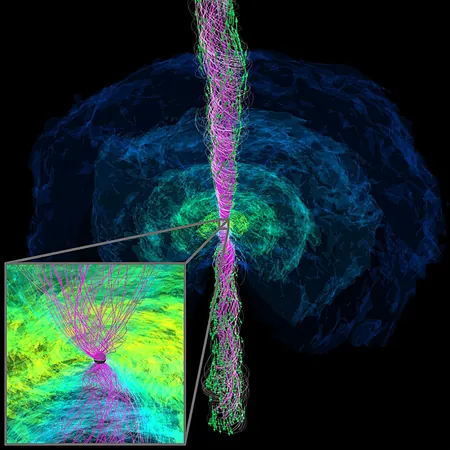
Stunning Simulation Unveils Cosmic Catastrophe: Jet Emerges from Neutron Star Merger and Forms Black Hole!
2025-06-16
Author: Ming
A Cosmic Collision Like No Other!
In a groundbreaking discovery, scientists have turned their sights to the explosive mergers of binary neutron stars—dense remnants of stellar evolution that pack unimaginable energy. These cosmic events, previously shrouded in mystery, have now caught the attention of researchers eager to unlock their underlying physics and potential cosmic consequences.
The Longest Simulation Yet!
A collaboration between the Max Planck Institute for Gravitational Physics, Yukawa Institute, and universities in Chiba and Toho has birthed the longest and most detailed simulation of neutron star mergers ever conducted. Utilizing the advanced neutrino-radiation magnetohydrodynamics (MHD) framework, the team modeled the complex interactions of magnetic fields, dense matter, and neutrinos under extreme conditions.
Revealing the Formation of a Black Hole!
Their riveting findings, published in the journal Physical Review Letters, reveal the birth of a magnetically dominated jet during the merger, followed by the immediate collapse of the neutron star system into a black hole. "In 2019, gravitational wave detectors picked up a signal from a similar merger that collapsed into a black hole right away," stated Kota Hayashi, the lead author. This research aims to deepen our understanding of such cataclysmic events and their multi-messenger signals, including gravitational waves and electromagnetic emissions.
High-Stakes Cosmic Physics!
The simulated binary neutron stars, with masses of 1.25 and 1.65 solar masses, were modeled using the SFHo equation of state, a complex mathematical representation of extreme stellar conditions. Hayashi elaborated, "We simulated the evolution of the gravitational field, neutrino radiation, magnetic fields, and hydrodynamics for an unprecedented 1.5 seconds of real time using the Japanese supercomputer Fugaku."
A Jet of Extraordinary Power!
Following the merger, the system collapsed rapidly into a black hole, creating a chaotic accretion disk—a swirling mass of material contributing to high-energy emissions. This process ultimately gave rise to a magnetically driven jet with an astonishing luminosity of around 10⁴⁹ erg/s, directed along the black hole's spin axis. Significant findings indicate that this merger type has the potential to trigger gamma-ray bursts, the universe's most powerful explosions, generated by the magnetic fields produced in the post-merger disk.
Future Implications and Further Research!
Hayashi noted, "This is the first evidence of such a magnetically driven jet emerging from a neutron star merger that immediately forms a black hole. The implications are monumental, suggesting a strong connection between neutron star mergers and the generation of gamma-ray bursts." However, the simulation focused mainly on the dynamics during the merger and the jet's launch, leaving room for further exploration of the electromagnetic emissions to support these findings.
What's Next for Astrophysics?
The remarkable speed of the jet, surpassing 99.9% of the speed of light, hints at the presence of acceleration mechanisms that have yet to be fully understood. Future studies will delve deeper into this acceleration process to unlock the full mysteries surrounding gamma-ray bursts and their connections to neutron star mergers.



 Brasil (PT)
Brasil (PT)
 Canada (EN)
Canada (EN)
 Chile (ES)
Chile (ES)
 Česko (CS)
Česko (CS)
 대한민국 (KO)
대한민국 (KO)
 España (ES)
España (ES)
 France (FR)
France (FR)
 Hong Kong (EN)
Hong Kong (EN)
 Italia (IT)
Italia (IT)
 日本 (JA)
日本 (JA)
 Magyarország (HU)
Magyarország (HU)
 Norge (NO)
Norge (NO)
 Polska (PL)
Polska (PL)
 Schweiz (DE)
Schweiz (DE)
 Singapore (EN)
Singapore (EN)
 Sverige (SV)
Sverige (SV)
 Suomi (FI)
Suomi (FI)
 Türkiye (TR)
Türkiye (TR)
 الإمارات العربية المتحدة (AR)
الإمارات العربية المتحدة (AR)